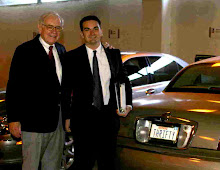Let's get things started.
The company is called Leggett and Platt. This fortune 500 company makes components - primarily for furniture and automobile interiors. This means everything from bed springs to lumbar systems. In fact, there is a good chance you are sitting on a Leggett component as you read this. This is a fairly simple business idea - the way Buffett likes them - and Leggett has consistently stayed in this industry throughout its 122-year history - another Buffett plus.
In my interaction with Mr. Buffett, in addition to most everything I have read, I understood that one of his primary concerns is the integrity of management. This includes its honesty, candor and rationality. A read through of the Leggett annual report is telling. The tone and content of the text sounds as if it could have been in the Berkshire annual report. The managers of the company own a large amount of Leggett stock, often representing a substantial portion of their net worth. Managers also frequently choose to forego a portion of their salary in exchange for stock options. Once these options are granted, they are expensed.
Although Leggett doesn’t have a "moat" around its business in the same way as Coca-Cola or See’s Candies, I assert that its moat is as large as any business-to-business enterprise’s could be. The company has a reputation for product quality and customer service, all while often being the lowest cost producer in the industry. Leggett also has very strong relationships with its customers. Many of its plants are located right next door to the customer, creating both efficiencies and loyalties for all parties.
The customer base is also diverse. No one customer accounts for more than 5% of company sales, providing each customer with relatively little buyer power.
Further, Leggett has experienced average annual growth in earnings of just over 15% since its IPO in 1967. However, as Mr. Buffett first pointed out in his 1977 annual report, strong earnings growth is not all that impressive without a comparable return on equity. Leggett’s ROE has averaged 15.9% since the IPO in 1967 and has been very consistent. The standard deviation in ROE over this time is only 3.5%. All this has been done without the undue use of leverage. Long term debt has historically averaged around 30% of total capital, although that ratio is currently closer to 20%.
As recently as last fall, Leggett stock was significantly undervalued. If we run a Buffett-esque discounted cash flow valuation we find that the current stock price still falls short of what such a valuation would produce. What do I mean by Buffett-esque DCF valuation? Consult his 1986 letter to shareholders in which he defines "owner earnings" as reported earnings plus depreciation, depletion, amortization, and certain other non-cash charges less the average annual amount of capitalized expenditures for plant and equipment, etc. We project these future "owner earnings" and discount them to present. Using even the most conservative assumptions of growth and discount rate, Leggett stock looks cheap.


1 Comments:
Update: Check out the profile in the April 17 issue of Fortune - thats the big "Fortune 500" issue. Page 40.
By Andy Kern, at 01 May, 2006 05:34
Andy Kern, at 01 May, 2006 05:34
Post a Comment
<< Home